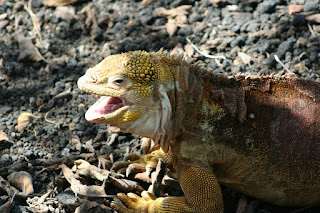The weather on the Galapagos archipelago - as with many island climates - is unpredictable and changeable. This morning saw a much cloudier, yet no less muggy start than yesterday.
Our purpose was to leave the island of San Cristóbal first thing, and make our way to Floreana by speedboat. The boat was only just big enough for the fifteen in our group, plus our guide, Mauricio, the captain and his mate. Heading southwest at a fairly steady 45km/h, it took around three hours to reach the smaller island of Floreana. The journey was decidedly bumpy as we drove directly into the wind and the large waves it caused. While some faces were greener than others, fortunately we all arrived without losing our breakfast (eggs again).
The island had the prestigious accolade of being named in honour of Ecuadorian President Juan José Flores when the archipelago was annexed for his country and a bid for population of the islands was made. However, the natural environment provided little water and, given time, settlements thrived much more on the more resource-rich islands of Santa Cruz and San Cristóbal. As such, the shore front is far less built up than the town we had just left and our accommodation at Lava Lodge was one of only a handful of buildings to be seen as we pulled into port. In fact, the huts bore a greater resemblance to beach chalets and our group represented a whopping 10% of the island's 150-strong population.
 |
| Lava Lodge |
On arrival, the port was teeming with marine life - iguanas, black with patches of angry red, lay with fat and lazy expressions on the hot flat surfaces, while sea lions and the unusual sight of a fur seal sat on the rocks among the red crabs.
 |
| Sea lions and marine iguanas |
At the Lava Lodge, bird life abounded, with plenty of Darwin's finches flitting from branch to branch. Aptly we were assigned the hut named pinzón - Spanish for finch - but it was the yellow warblers that caught our attention, as streaks of colour, motionless only for an instant before darting away.
 |
| Yellow warbler |
Although the island only has a few inhabitants, the history makes for interesting reading, and could well have come from a work of fiction.
This account provides a good summary of the unusual events, which starts with a couple of reclusive and misanthropic Germans, the Wittmers, seeking a peaceful and people-free existence on the island in 1929. Free of people, however, it did not remain for long, as a copycat pair, the Ritters, followed in their footsteps, lured by tales of the remote existence chronicled by the Wittmers in a German periodical. The two couples led isolated lives until the arrival of an eccentric Baroness and her two paramours. Like a cat among the pigeons, the baroness' behaviour caused much wrinkling of the Teutonic noses until the "neighbour from hell" disappeared with one of her lovers, never to be seen again. Shortly thereafter, the jilted second lover made for the mainland, only to have his corpse turn up later on a beach. Even more mysteriously, Ritter, a committed vegetarian, subsequently died after eating a bowl of chicken soup.
 |
| Bust of Rolf Wittmer |
Long before this group of bizarre miscreants arrived, Floreana was home to the iconic giant tortoises that are always called to mind at a mention of the Galapagos. These unbelievable creatures somehow made their way across the ocean to populate the islands before the arrival of Man. Whalers, as is their wont, killed much of the indigenous population for meat and oil. Sadly, in addition to direct hunting, the shelled reptiles suffered indirectly from Man's introduction of another grazing species: the goat. Unlike Aesop's fable, in The Tortoise and the Goat, the reptile lost out to its faster competitor, which ate the food source much more quickly, causing numbers to take a nosedive. As such, the tortoises currently residing on the island are domesticated, having been reintroduced presumably out of a sense of nostalgia and posthumous guilt.
 |
| I don't believe it |
After lunch at one of the few restaurants on the island, Lelia's, we ignored received wisdom and went swimming. Snorkelling, to be precise, off the black sand of the beach in the shallows that are home to stingrays and the cousin of the land-based tortoises, enormous and serene-looking giant marine turtles.
 |
| Snorkelling on Floreana |
As the sun went down, we viewed it from from the old Wittmer hotel, now owned by the Cruz family with a cold beer. After dark, we trooped back to Lelia's for dinner of soup, in which fried banana 'croutons' replaced the more common popcorn, spaghetti and vegetables, followed by a tasty banana cake.





















































